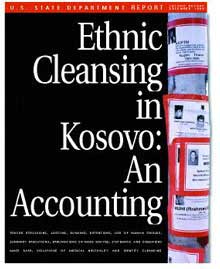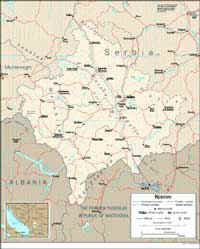| Source: http://www.state.gov/www/global/human_rights/kosovoii/homepage.html Accessed 12 December 1999
Ethnic Cleansing in Kosovo: An Accounting is a new chapter in our effort to document the extent of human rights and humanitarian law violations in Kosovo, and to convey the size and scope of the Kosovo conflict. The information in this report is drawn from refugee accounts, NGO documentation, press accounts, and declassified information from government and international organization sources. The atrocities against Kosovar Albanians documented in this report occurred primarily between March and late June, 1999. This document is a follow-up to the U.S. Department of State's previous human rights report, Erasing History: Ethnic Cleansing in Kosovo, which was released on May 10, 1999. A central question is the number of Kosovar Albanian victims of Serbian forces in Kosovo. Many bodies were found when KFOR and the ICTY entered Kosovo in June 1999. The evidence is also now clear that Serbian forces conducted a systematic campaign to burn or destroy bodies, or to bury the bodies, then rebury them to conceal evidence of Serbian crimes. On June 4, at the end of the conflict, the Department of State issued the last of a series of weekly ethnic cleansing reports, available at www.state.gov/www/regions/eur/rpt_990604_ksvo_ethnic.html concluding that at least 6,000 Kosovar Albanians were victims of mass murder, with an unknown number of victims of individual killings, and an unknown number of bodies burned or destroyed by Serbian forces throughout the conflict. On November 10, 1999, ICTY Chief Prosecutor Carla Del Ponte told the U.N. Security Council that her office had received reports of more than 11,000 killed in 529 reported mass grave and killing sites in Kosovo. The Prosecutor said her office had exhumed 2,108 bodies from 195 of the 529 known mass graves. This would imply about 6,000 bodies in mass graves in Kosovo if the 334 mass graves not examined thus far contain the same average number of victims. To this total must be added three important categories of victims: (1) those buried in mass graves whose locations are unknown, (2) what the ICTY reports is a significant number of sites where the precise number of bodies cannot be counted, and (3) victims whose bodies were burned or destroyed by Serbian forces. Press accounts and eyewitness accounts provide credible details of a program of destruction of evidence by Serbian forces throughout Kosovo and even in Serbia proper. The number of victims whose bodies have been burned or destroyed may never be known, but enough evidence has emerged to conclude that probably around 10,000 Kosovar Albanians were killed by Serbian forces. Death represents only one facet of Serbian actions in Kosovo.Over 1.5 million Kosovar Albanians--at least 90 percent of the estimated 1998 Kosovar Albanian population of Kosovo--were forcibly expelled from their homes. Tens of thousands of homes in at least 1,200 cities, towns, and villages have been damaged or destroyed. During the conflict, Serbian forces and paramilitaries implemented a systematic campaign to ethnically cleanse Kosovo--aspects of this campaign include the following:
Forcible Displacement of Kosovar Albanian Civilians: Serbian authorities conducted a campaign of forced population movement. In contrast to actions taken during 1998, Yugoslav Army units and armed civilians joined the police in systematically expelling Kosovar Albanians at gunpoint from both villages and larger towns in Kosovo. Looting of Homes and Businesses: There are numerous reports of Serbian forces robbing residents before burning their homes. Another round of robbery occurred as Serbian forces stole from fleeing Kosovars as they crossed the border to Montenegro, Albania, or Macedonia. Widespread Burning of Homes: Over 1,200 residential areas were at least partially burned after late March, 1999. Kosovar Albanians have reported that over 500 villages were burned after March, 1999.
Detentions: Serbian forces systematically separated military-aged men from the general population as Kosovars were expelled. These men were detained in facilities ranging from cement factories to prisons. Many of these detainees were forced to dig trenches and were physically abused. At least 2,000 Kosovar Albanians remain in detention in around a dozen Serbian prisons today. Summary Executions: There are accounts of summary executions at about 500 sites across Kosovo. Exhumation of Mass Graves: Serbian forces burned, destroyed, or exhumed bodies from mass graves in an attempt to destroy evidence. Some were reinterred in individual graves. Rape: There are numerous accounts indicating that the organized and individual rape of Kosovar Albanian women by Serbian forces was widespread. For example, Serbian forces systematically raped women in Djakovica and Pec, and in some cases rounded up women and took them to hotels where they were raped by troops under encouragement of their commanders. Rape is most likely an underreported atrocity because of the stigma attached to the victims in traditional Kosovar Albanian society. Violations of Medical Neutrality: Kosovar Albanian physicians, patients and medical facilities were systematically attacked. Many health care facilities were used as protective cover for military activities; NGOs report the destruction by Serbian forces of at least 100 clinics, pharmacies, and hospitals. Identity Cleansing: Kosovar Albanians were systematically stripped of identity and property documents including passports, land titles, automobile license plates, identity cards, and other forms of documentation. As much as 50 percent of the population may be without documentation. By systematically destroying schools, places of worship, and hospitals, Serbian forces sought to destroy social identity and the fabric of Kosovar Albanian society. Aftermath: Following the withdrawal of Serbian forces in June, Kosovo saw manifestations of a new set of human rights problems. These include acts of retribution against the Serb minority, including the killing of 200-400 Serb residents. In addition, as many as 23,000 conscientious objectors, draft evaders, and deserters in Serbia are threatened with legal action. |
||||||||||||||||||


Use of Human Shields: Refugees claim that Serbian forces
used Kosovar Albanians to escort military convoys and shield facilities
throughout the province. Other reporting indicates that Serbian forces
intentionally positioned ethnic Albanians at sites they believed were
targets for NATO airstrikes.
Use of Human Shields: Refugees claim that Serbian forces
used Kosovar Albanians to escort military convoys and shield facilities
throughout the province. Other reporting indicates that Serbian forces
intentionally positioned ethnic Albanians at sites they believed were
targets for NATO airstrikes. Document compiled by Dr S D
Stein
Document compiled by Dr S D
Stein